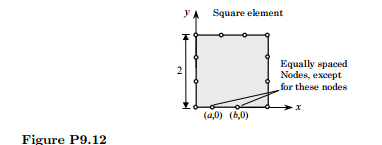For a 12-node serendipity (cubic) element, as illustrated in Fig. P9.12, show that the Jacobian J…
For a 12-node serendipity (cubic) element, as illustrated in Fig. P9.12, show that the Jacobian J… | savvyessaywriters.org
For a 12-node serendipity (cubic) element, as illustrated in Fig. P9.12, show that the Jacobian J = J11 is

What can you conclude from the requirement J > 0?

sol$
We have (after a lengthy algebra using Maple)

Thus J = J11 > 0 ensures a unique transformation and preservation of the sense of the coordinate system in the master rectangular element, provided a and b are such that
5.5 − 1.125(a + b) − 3.375(b − a) > 0 and 1.0+1.125(a + b) − 3.375(b − a) > 0
The above inequalities place a restriction on the values of a and b. Clearly, for a > 0.666667 and b = 1.333333 (the usual location of the midside nodes), the inequalities are met (i.e., J = 1 > 0). A plot of the Jacobian shows, for example, that J = 0 when (i) a = 0.27777 = 5/18 and (ii) b = 1 and J < 0=”” for=”” a=”0.27777″ and=”” any=”” b=””><>
Do you need a similar assignment done for you from scratch? We have qualified writers to help you. We assure you an A+ quality paper that is free from plagiarism. Order now for an Amazing Discount!
Use Discount Code “Newclient” for a 15% Discount!
NB: We do not resell papers. Upon ordering, we do an original paper exclusively for you.

The post For a 12-node serendipity (cubic) element, as illustrated in Fig. P9.12, show that the Jacobian J… appeared first on Affordable Nursing Writers.

